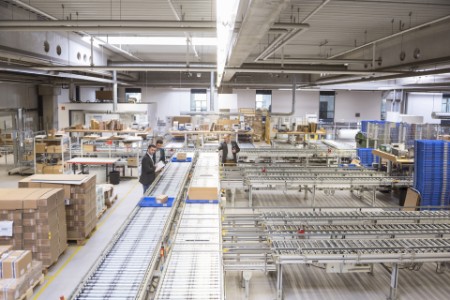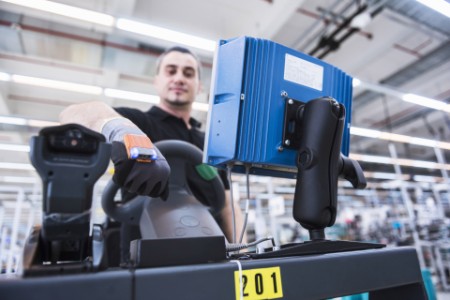
Chapter 1
The disruption
Organizations talk about innovation and agility as part of this kind of wholesale transformation. Often, they don’t know where to start.
Digital technologies have defined the Fourth Industrial Revolution, creating a new norm of connected enablement fueled by technology such as artificial intelligence (AI) and intelligent automation (IA), analytics, the cloud and the Internet of Things (IoT).
This type of disruption has upended traditional strategies and business models. Organizations know they need to fundamentally reinvent their supply chain to meet the needs of today’s digitally savvy consumer, orchestrate a complex ecosystem from suppliers to customers, and deliver on increasingly demanding cost and cash-saving demands.
Organizations talk about innovation and agility as part of this kind of wholesale transformation. Often, they don’t know where to start. The result is top-down innovation with “shot-in-the-dark” execution that results in analysis paralysis.
There is no way to align a changing ecosystem without leveraging technology. However, for supply chain organizations to take advantage of all of the connected technologies the Fourth Industrial Revolution offers, they need to do more than implement the shiniest new technologies with all of the bells and whistles. They are going to have to make the leap from doing digital to being digital.

Chapter 2
The urgency
Organizations looking to thrive need to identify the game changer in their reinvention, an approach that has kept incumbent organizations at the top of their game.
The shelf life of a Fortune 500 company has decreased from 61 years to 18 years. In 2017, the top five Fortune 500 companies largely comprised traditional companies — Walmart, Berkshire Hathaway and Exxon Mobil. Only one technology company (Apple) cracked the top five. This year, Fortune also compiled a list of Future 50 companies (a new ranking of companies best positioned for breakout growth), and all of the top five on the leader list — Salesforce, Tesla, Facebook, Netflix and Intuitive Surgical — are digitally based and digitally driven.
The competitors you know today aren’t necessarily going to be who you are competing against tomorrow or next week or next year. And the ones that will be sticking around have, in many cases, already figured out the game-changing step to reinvention that keeps them competitive with next-generation organizations.
Organizations looking to stay relevant 5 to 10 years from now, among incumbents and upstarts alike, need to identify that game-changing step as part of their own supply chain transformation.

Chapter 3
The impact
Embedding connected technologies into your supply chain transformation strategy can lead to exponentially greater benefits across the enterprise.
Organizations can try to cut their way to the bottom to maintain eroding margins. Or, they can empower the organization to keep pace with a changing world.
Exploiting AI, IA, robotics and analytics as adjacent foundational capabilities of automation, and as part of a transformation that makes the leap from doing digital to being digital, leads to exponentially greater benefits in every facet of the enterprise.

Chapter 4
The solution
A safe, methodical and collaborative approach to supply chain transformation that has top-down leadership support and equally balances business needs with technology imperatives.
Supply chain transformation requires a safe, methodical approach that has top-down leadership support and equally balances business needs with technology imperatives. Here are five steps that will help your organization’s supply chain transformation.
1. Define a purpose and strategy to manage change
Define a clear purpose and strategy to better manage change in the organization. Conducting ad hoc pilots without a strategy and focusing solely on cutting costs and reducing headcount are recipes for failure. Reduced costs and freed-up capacity are benefits of automation tools, but realizing those benefits through a strategic purpose is key. The real value is the way in which technologies work on top of the existing infrastructure, allowing established companies to become more agile, increasing flexibility and adaptability within the organization, and creating a platform for change.
2. Lead with business imperatives while integrating with technology
Lead with business imperatives even as you are integrating the right technical experience. Business models need to be challenged to drive transformation and value. The examples of stranded “bots” or failed programs because an organization developed a technology-driven approach without including functional and industry experience are too numerous to count. A strong combination of the two is key to driving value. Together, you need to identify when to first standardize and harmonize a process versus automating it as is. You also need to have a strategy that identifies the role automation plays. Is it a short-term solution until a next-generation technology can provide a solution? Am I trying to plug the gaps in the process left after implementation of a new system? Or, am I looking for a fully formed long-term solution?
3. Foster culture that emphasizes an agile, speedy, fail-fast, iterative approach
Create a fail-fast culture where employees are applauded for taking chances without betting the bank. This does not mean hiring a scrum master and using a modified approach, nor does it mean driving transformation by cutting costs. Instead, employees need to be encouraged to act fast to deliver results and learn from the successes and failures.
4. Create scalability and sustainability through governance and an operating model
Creating a scalable and sustainable platform for growth is about more than technology. To be successful, you’ll need a platform and operating model that support the agile environment you’ve created. Automation is a business capability that requires coordination across organizational lines and necessitates a balance of business enablement with oversight. Focus on a framework for implementing an operating model that promotes value and mitigates the risk at this scale.
5. Secure top-down leadership support and look to partners with the right talent for help
Transformation needs support from the top; executive sponsorship is critical. The speed at which technology is changing makes transformation ultra-challenging. A strong partner is imperative to co-innovate and support the overall journey. Technology is disrupting too fast for most companies to build and retain the necessary talent.

Chapter 5
The bottom line
Walk the talk on innovation and agility with a supply chain transformation that helps make the leap from doing digital to being digital.
Supply chain transformation can prove to be a key differentiator in your ability to not only survive but thrive in an era of constant disruption — if you have the right ingredients for reinvention and you can make the leap from doing digital to being digital. Machine learning, for example, can improve forecasting accuracy by as much as 15%. Chatbots used to streamline source-to-pay processes can drive efficiencies of up to 40% while reducing cycle time. And blockchain can provide end-to-end traceability while reducing stock outages and delivery issues.
Cutting your way to the bottom is a short-term and short-sighted solution. Similarly, an improvised strategy that focuses on doing digital will prove costly and ill-conceived.
Taking a thoughtful, collaborative approach that fosters a culture of agility, speed, iteration and failing fast moves the organization to a place where digital is a way of being, and with the generated executive support, supply chain organizations can shake off their analysis paralysis and walk the talk on their way to competitive dominance.
Summary
Organizations talk about innovation and agility. But when it comes to “walking the talk,” supply chain organizations need to do more than implement new technologies. They need to make the leap from doing to being digital.


